In this blog, you will learn about the significance of Chitrakoot. You will come to know why Chitrakoot Dham is famous, which river flows through Chitrakoot, Where is Chitrakoot Dham located, what are the top tourist places ( Top 10 Destinations in Chitrakoot Dham ) in Chitrakoot, the history of Chitrakoot Dham, the best season to visit Chitrakoot as well as its relevance with Ramayana.
Contents
Chitrakoot Dham – Why is Chitrakoot famous?
Chitrakoot Dham is known as the “Place Of Many Wonders”. It is a part of the North Vindhyan Mountain Range. This makes it a great spot for adventure lovers. Chitrakoot Dham is also famous for religious and spiritual reasons.

History of Chitrakoot
According to a belief, Chitrakoot got its name because of the presence of “Cheetal” – Hindi word for deer. Deer are found in abundance in the region hence the name.
Ancient History
According to Pauranic verses, many ancient sages, saints and thinkers lived from time immemorial in Chitrakoot. Some of them being Atri, Anusuya, Dattatreya, Maharishi Markandeya, Sarabhanga, Sutikshna. Since this place has many natural caves that are ideal for penance.
According to some local beliefs, Chitrakoot Dham is given higher status than Prayagraj. Prayagraj is called the “King of all Pilgrimages”. All those who cannot go to Prayagraj can visit Chitrakoot. In Chitrakoot Dham devotees take bath in Payasini river.
Payasini river is mentioned in the Ramcharitmanas of Tulsidas. According to Tulsidas, Payasini river flows through Chitrakoot.
Valmiki Ramayana describes Chitrakoot
Maharishi Valmiki wrote Ramayan during the Rigvedic time of ancient history. Ramayana is the oldest epic in the world. In it, Valmiki describes the scenic beauty of Chitrakoot. He mentions that Chitrakoot Dham is a holy and pious place. It is inhabited by great saints and sages.
Bharadwaj Rishi advised Lord Rama to go to Chitrakoot Dham
One of the Great 7 Hindu sages ( Sapta-Rishi ) – Bharadwaj advised Lord Rama to make his abode at Chitrakoot during the exile period. When Lord Rama left Prayagraj, he was searching for a suitable place to live. Therefore he went to Bharadwaj Rishi in Prayagraj for suggestions. There he told Lord Rama about a place called Chitrakoot.
According to Bharadwaj Rishi, Chitrakoot was the perfect place to live. It had natural caves in the dense forests of Dandakaranya. Also, he told Lord Rama that many demons were oppressing the saint in the region. So in this way, Lord Rama can kill those demons and bring respite and relief to the sages. Lord Rama himself acknowledged the spiritual effect of this place after he resided there.
Ancient Texts and Books describing Chitrakoot Dham
Chitrakoot Dham has been mentioned in various ancient, medieval and modern texts.
Mahabharata
The Ramopakhyan section in Mahabharat tells the tale of Lord Rama and Sita. There are 704 verses in the section and some of the describe the beauty of Chitrakoot Dham. Also, there is a description of the pilgrimage at various other places in Mahabharat.
‘Adhyatma Ramayana’ and ‘Brihat Ramayana’
‘Adhyatma Ramayana’ and ‘Brihat Ramayana’ were written in the 13th-15th century in Sanskrit. They attest to the shocking spiritual and natural beauty of Chitrakoot Dham.
Later on, the description of Chitrakoot and its main places started to be described as sixteen Kanto. Chitrakoot Dham has been accorded a unique and important distinction in the entire Indian literature related to Lord Rama.
Mackenzie’s collection
Father Camille Bulcke mentioned ‘Chitrakoot-Mahatmya’. He was a Belgian Jesuit missionary in India. He was known as “India’s most renowned Christian Hindi scholar”. This account is in Mackenzie’s collection.
Kalidas
Mahakavi Kalidas gave a beautiful description of this place in his book ‘Raghuvamsha’. Kalidas was so impressed by the beauty and atmosphere of Chitrakoot that he made it the place of his Yaksha’s exile in ‘Meghdoota’. He called Chitrakoot Dham Ramagiri – Rama meaning Lord Rama and Giri meaning mountain- because of its revered relationship with Lord Rama.
Tulsidas
Great Saint Tulsidas mentioned Chitrakoot with the utmost respect in all his major Hindi works such as Ramacharita Manas, Kavitavali, Dohavali and Vinay Patrika. In the work of Vinaya Patrika, there are several verses displaying a deep personal bond between Tulsidas and Chitrakoot. He spent a considerable part of his life at Chitrakoot Dham worshipping Lord Rama and longing for his darshan. According to a local belief, Tulsidas got the darshan ( glimpse ) of his beloved Lord Rama in the mediation of Hanumana.
Rahim
Hindi poet Rahim (Abdur Rahim Khan e Khana) was a friend of Tulsidas. He was a soldier, politician, saint, scholar, poet as well as one of the nine gems Nav-Ratnas of Akbar. He spent some time in Chitrakoot when he worked under Jahangir, the son of Akbar.
Mahamati Prananath
According to the Vitak Katha, a literature of the Pranami sect, the saint poet Mahamati Prananath wrote two books – ‘Chhota Qayamat Nama’ and ‘Bada Qayamat Nama’ at Chitrakoot Dham.
Chitrakoot and Ramayan
Chitrakoot Dham has an atmosphere of spirituality and religious smell in its air. Lord Rama, the hero of Valmiki’s Ramayana as well as Tulsidas’s Ramcharitmanas, spent 11 years out of 14 years of exile in Chitrakoot.
Lord Rama, his wife Sita and brother Lakshamana were ordered exile for 14 years by his father Lord Dasharatha. Lord Dasharatha, king of Ayodhya had 3 wives. One of them Kaikeyi was granted 3 wishes by King Dasharatha. She asked that Lord Rama should be sent to exile for 14 years and son of Kaikeyi, Bharat should be coronated to the crown.
It is also believed that Lord Rama performed the last rituals of his father ( known as ‘Shradha’ in Indian tradition ) in Chitrakoot. According to a folktale, all the gods and goddesses came to earth to attend the feast on the 13th day of the Shradha. They were mesmerized by the beauty of Chitrakoot. So they refused to go back to Heaven. Vice Chancellor Saint Vashishtha realized their desire and forgot to chant the immersion hymn. As a result, all gods and goddesses made Chitrakoot Dham a permanent place of residence.
Geography and Natural Beauty of Chitrakoot Dham
Chitrakoot Dham is situated in both states of Madhya Pradesh and Uttar Pradesh. Some of the parts of it lie in the district Satna in Madhya Pradesh while the rest of it lies in the Uttar Pradesh district named Chitrakoot.
The area is mostly made from ancient lava rocks and large stretches of wood interspersed with rivers.
Politically the place is surrounded by the Kaushambhi district in the north, Rewa district in the south, Prayagraj district in the east and Banda district in the west. The topography of the place is mountainous in nature. Degrades hills and plateaus surround the place making a picturesque landscape.
The river Payaswini, also known as Mandakini flows through the city. The Mandakini river ( named Payaswini in Ramcharitmanas ) is the lifeline of the city.
Nature is at the top of its beauty in Chitrakoot Dham. Here one can find monkeys, cows, deer etc. Monkeys are in a lot of numbers. There are two types of monkeys found in Chitrakoot Dham – One with a red face and the other with a black face. The red-faced monkeys are said to be more aggressive than the black-faced monkeys. Another interesting fact is that the black-faced monkeys are found more in the Madhya Pradesh area and the red-faced more in the Uttar Pradesh part!
Top (10) Tourist Places/Destinations in Chitrakoot
Chitrakoot is known for its various religious and natural tourist spots. It attracts thousands of devotees and nature lovers each year. If you visit Chitrakoot you must not miss the following amazing places that will blow your heart away with their beauty.
Kamad Giri
Kamad Giri is a mountain situated in Chitrakoot. It is believed to be the original place where the main city was situated. It is the place where Lord Rama used to stay during his exile period. Today it is the main place for devotees to visit. For the convenience of the devotees, Kamad-Giri mountain is skirted along its base by a circular path. Teen shades are erected all along so that people don’t get affected either by sun or rain or any other weather harshness.
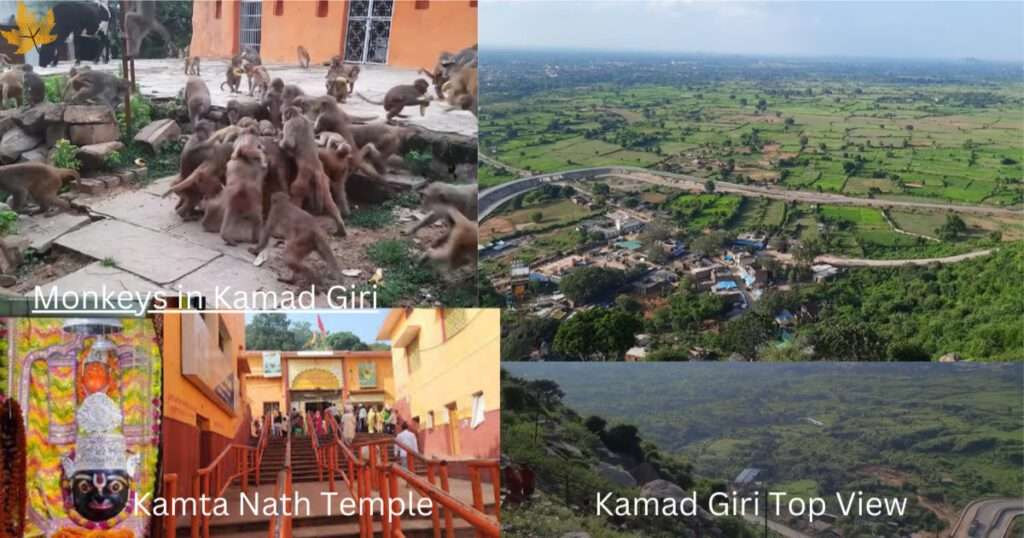
Along the pradakshina-patha there are a number of temples. The patha starts with the darshana of Kamata-Nath temple. The temple is in the Majhagawan tehsil of Satna district in Madhya Pradesh. From here the 5 kilometres long circularparikrama marga starts.
Bharat Milap temple
The Bharat Milap temple is situated along the parikrama marg around the Kamadgiri mountain. It is believed that here Lord Rama and Bharat (the younger brother of Rama ) met during the exile. According to Ramayana, Bharat came here to persuade Lord Rama to return to Ayodhya and accept the throne as King. Here footprints of the brothers are found embellished on a stone structure.
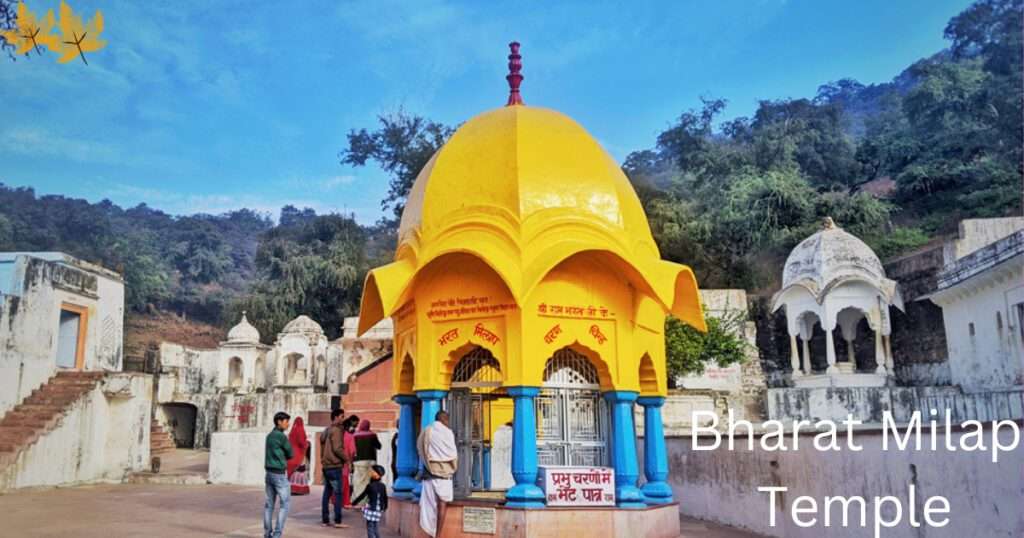
Lakshman Pahari
Lakshman Pahari is a small hill located near Bharat Milap temple along the Parikrama-Marg. It is believed that during the life of Lord Rama in the forests, Lakshaman used to guard the area as a watchman from this hilltop.

There are stairs to reach the hilltop. There is also a service of the ropeway to reach the top. The price of it is also very minimal. It is Rupees 75 for adults for both ways and Rupees 35 for a single way. The price is less for children.
It is believed that the wife of Megha-nad, brother of Ravana, got vardaan that only a person who never sleeps can kill her husband. Therefore Lakshaman never slept and guarded the Kadam Giri ( the original Chitrakoot hill ) where Lord Rama and Mata Sita used to live.
Here people come and hug the pillars. It is said that by doing so all problems of the physical body go away and a person lives a healthy life. There is a temple of Mansa Devi here. Footprints of Lakshaman are also found on a stone structure.
Hanuman Dhara
Hanumana Dhara is located on a hilltop. It is at a height of hundred feet with a steep slope. It is believed that when Lord Hanuman returned from Lanka after setting it on fire, Lord Rama created a spring at this place to assuage Hanuman.
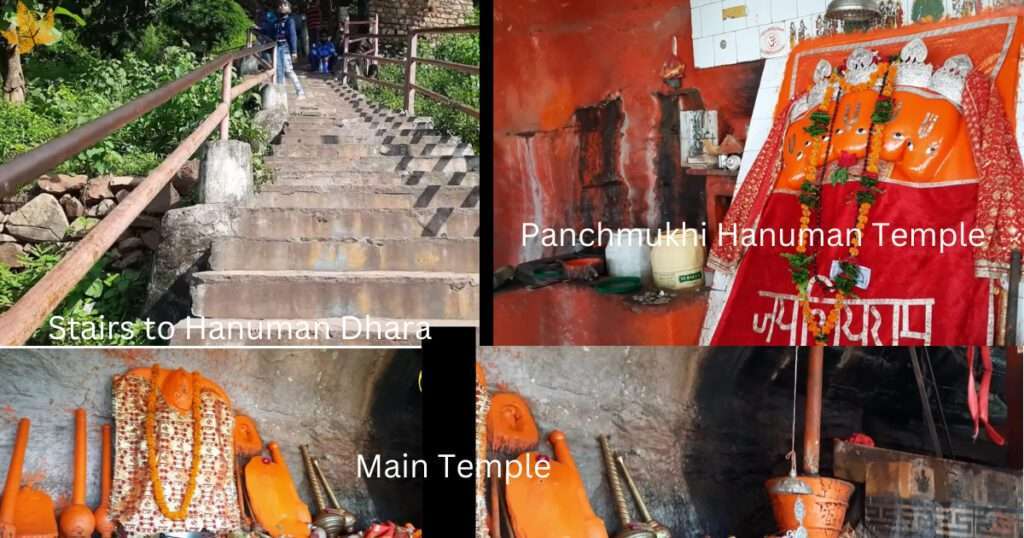
Hanuman set Lanka afire with his tail. When he returned to Chitrakoot he had some injuries on his tail. So to help Hanuman and relieve him of his pain, Lord Rama used his bow arrow to create a spring to cure burns.
There are 650 steps to reach the main temple. In between the climb, you will encounter the Panchmukhi Hanuman Temple. Here is an idol of Lord Hanumana who have 5 faces hence the name. Climbing another few steps, you will reach the main temple. Here the idol is washed by naturally dripping water from the caves. Nobody knows the origin of this water as well as the end.
Today, there are cascading streams of water falling on an idol of Lord Hanuman at this landmark site. This place is best for trek lovers who want to enjoy the beauty of nature at its best.

Some temples are found here. There are some site-seeing top spots from where you can enjoy the panoramic view of the Chitrakoot Dham. There are stairs to reach the hilltop. Various Peepal trees provide relief during the summer as well as the rainy season. An open and paved area provides a resting place for people after some steep climbs. You can also take the ropeway to reach the height.
Sita Rasoi
After climbing some 180 stairs you will reach another cave. This cave is known as Sita Rasoi. Rasoi is a Hindi word meaning Kitchen. Maa Sita cooked some food here. Maybe boiled some Kandamool! However, there are many priests who will ask for money here. Be aware of them. You may feel slightly disappointed after reaching here because the place has lost its naturality. Although you can see the beautiful Jungles from the top view.

Janki Kund
Janki Kund is a place alongside the river Mandakini. According to some fables, at this place, Mata Sita used to bathe during her stay in Chitrakoot Dham. There are evidence of footprints of her at this place. There is a small yagya-vedi at this place. It is said that Lord Brahma used to perform Yagya rituals at this place.

There is also a small tank at this place locally known as Kunda. Here Mata Sita used to bathe daily. After taking bath, she would go to Sphatik Shila.
There are two ways to reach Janaki Kund –
- 2 km up from Ramghat by boat
- by the road along a foliage-lined drive
Sphatikshila
Sphatik Shila is the famous “Crystal Rock”. It is a large boulder on the banks of the Mandakini river. According to the locals, Lord Rama used to rest on it. He along with Mata Sita would sit down and admire the natural scenic beauty of the place. There are footprints of both on the boulder which are worshipped by devotees. There is interesting folklore. The same is mentioned in the Ramayana.
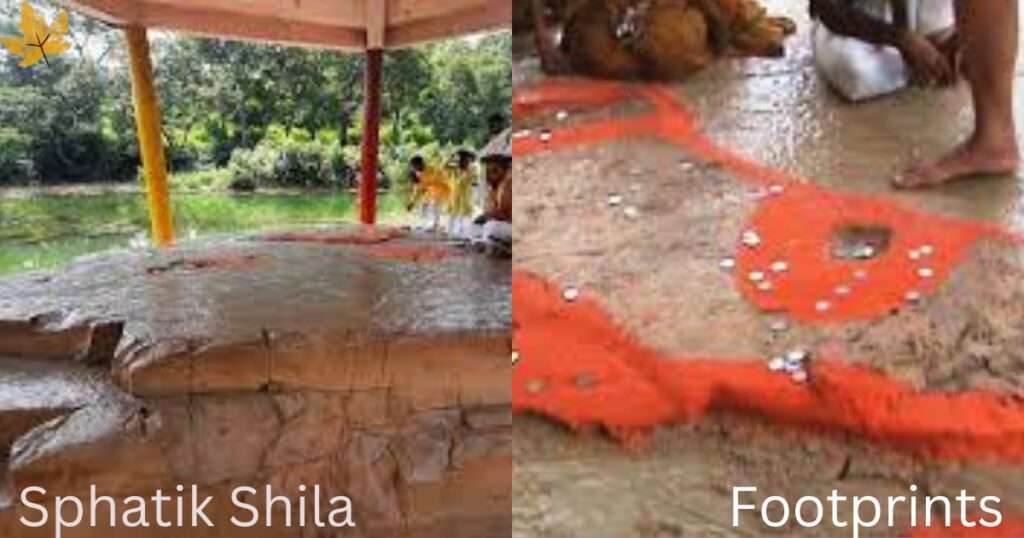
According to it, on one fine day, Lord Rama was resting his head in the lap of Mata Sita. Suddenly a crow came and attacked Mata Sita. Mata Sita got hurt with injuries on her feet. Lord Rama woke up and recognized the crow as the son of Indra, the god of heaven. Lord Rama attacked the crow and the crow fled to Indra for his life. Being refused, the crow returned to Lord Rama for forgiveness. But Rama said that the weapon once released from the bow can’t be taken back. So the crow offered his right eye to be hit.
Gupt Godavari
Gupta meaning hidden – Gupt Godavari is a place that is 18 kilometres away from the main city of Chitrakoot. It is located amidst the green lushes of a hill. There are two caves in the natural arch form that draw many visitors.
One of the caves is very high and wide in diameter. However, the entrance of this cave is narrow and small. Inside this large cave, you can feel some suffocation because there is no prominent space for air circulation. Ventillation is poor. I went to the place with my family. My sister started feeling suffocation so she rushed back outside immediately without even seeing the various spots inside the cave.
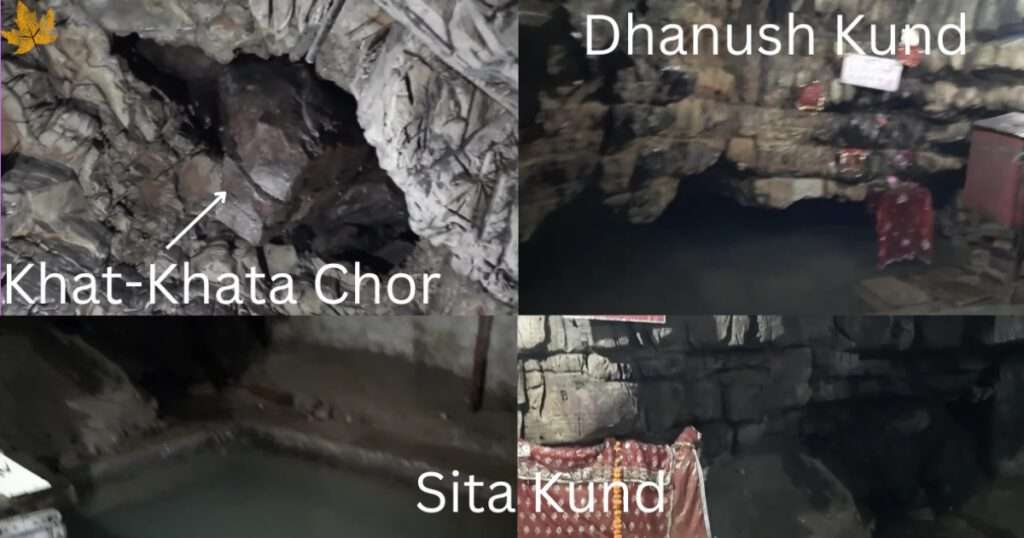
However, in this cave, prominent spots are :
Ram Darbar
Here there are three idols- Rama, Sita and Lakshmana. It is believed that Lakshamana used to conduct a durbar here.
Sita Kunda
It is a tank-type structure filled with water. Maa Sita used to bathe here.
Dhanush Kunda
This spot is said to be the origin place of the Godavari river. However, if scientists are to be believed, there is no such proof of the origin of the river. Nobody knows where the water comes from.
Khat-Khata Chor
It is believed that Khat-Khata Chor was a demon. He stole the clothes of Mata Sita. As a punishment, Lakshamana gave him a life sentence. The rock structure hanging above the roof is believed to be this demon.
There are also incarnations of Brahma, Vishnu and Mahesh.
There is another cave which is filled with water. This cave is very narrow throughout its course, unlike the first cave. You will have to fold your pants above the knee to be able to walk without getting your clothes wet.
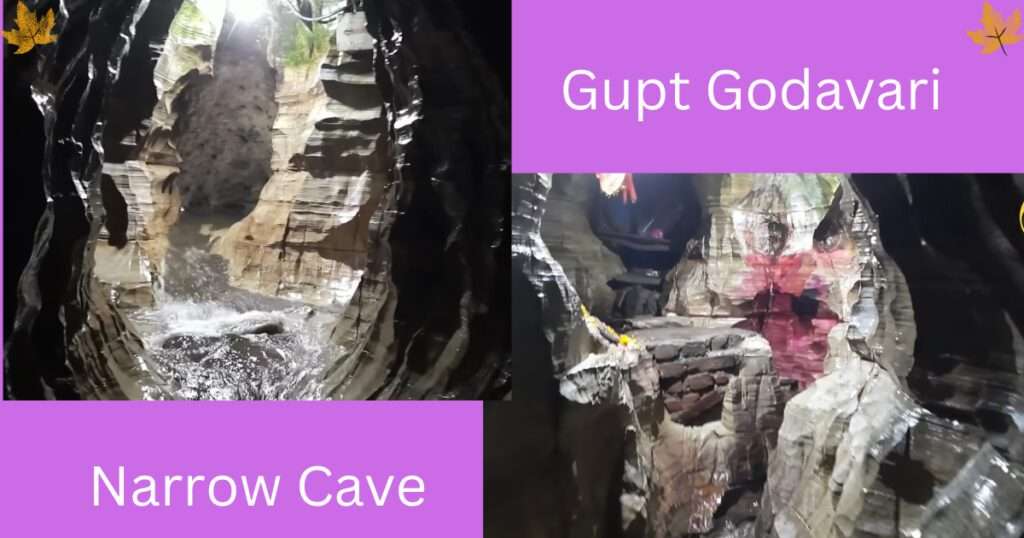
Lord Rama created Gupta Godavari so that Mata Sita can take bath inside. Another belief says that to meet Lord Rama, Godavari Maa came here in hidden form from Nasik. In Nasik, the Godavari River originated.
You will need to take tickets from the counter. It is advisable to visit the place in the morning as post morning the crowd start getting huge. You have to buy a single ticket for both caves. They will announce that you have to take offerings worth 10 rupees but if you don’t want to buy avoid it. It is not a compulsory thing to do. Timings are from 7 A.M. to 6 P.M. There are various hotels, and dhabas, especially that provide traditional local food.
Scientists explain that the caves formed as a result of a strange phenomenon that took place about 65 million years ago. It is a long, narrow crack. It was formed due to hot and molten lava oozing out and spreading across the surface. When the lava cooled, it formed flat-topped plateau-like structures giving distinctive features to the cave.
Ram Ghat
Ram Ghat is situated on the bank of the Mandakini river in the heart of the city. It is not very far from the Kamadgiri. It is said that Lord Rama used to take bath here. Lakshamana also used to bathe on this bank. Here you will witness highly decorated boats. You should come here in the evening. I took the boat for Rupees 800. You must know the art of negotiation though!
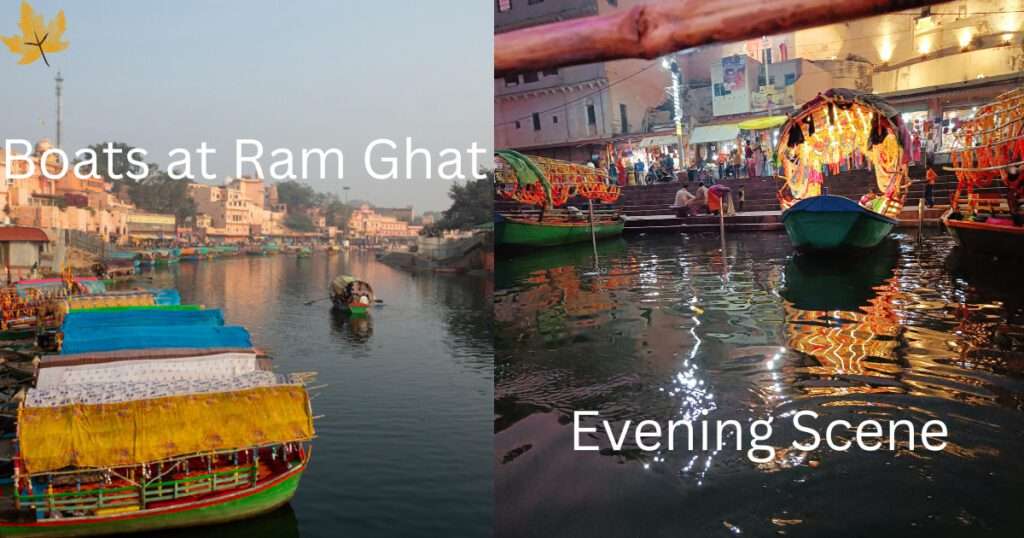
In the evening, the scene is so beautiful that it cannot be expressed in words. The boat will take you to many temples on both banks. There is no alternate way to reach the other side of the river. there is a big idol of Hanumana on the other side. The main bank where you will find the boa is Uttar Pradesh and the other bank is in Madhya Pradesh. Hence the boat takes you to have a presence in both states!
The boatman told us that the Mandakini river flows very slowly. In Hindi slowly is called mand. And therefore it got its name. You can take flowers and diyas. You can light them and float them on the bluish-green waters of the river.
Anasuya Ashram
Sati Anasuya was the wife of Rishi Atri. He was one of the seven most renowned saints of Hinduism. Anasuya Ashram is the place where he and his wife Anasuya Ji used to live. There he practised meditation. The ashram is also located along the banks of the Mandakini river. Here Atri, his wife Anasuya, and their three sons (who were the three incarnations of Brahma, Vishnu and Mahesh), are said to have meditated.
The Ashram is situated about 16 kilometres from the main town. You will see the dense forests along the roads. The river is very beautiful here. At a spot before the Ashram, a small stair-like check dam is built to enhance the flow of gushing water.
The River Mandakini is believed to be created by Anasuya through her meditation. Here is the origin of the river. Here you will find many fishes and also feed them.
Bharat Koop
Bharat Koop – Koop is a Hindi word meaning well. Here is a small dug-down well where Bharat collected and put the water from 5 main pilgrimages of India. Hence the water here is of religious and pious nature. This place is situated as an isolated spot 20 kilometres away from the main town. It is on the Dronachal Hill. You can see this place while going towards the Bundelkhand Expressway.
Devanagana Hill
This is a hill situated beside the Hanuman Dhara. However, the pathway to reach the top is difficult and unsurfaced. After reaching the top you will see natural water falling from the arch cave. Nearby is the Jamavant Cave – After Lord Ram left Chitrakoot, the vanar sena was stationed there. You can visit the Kotitirth and the Devangana caves.
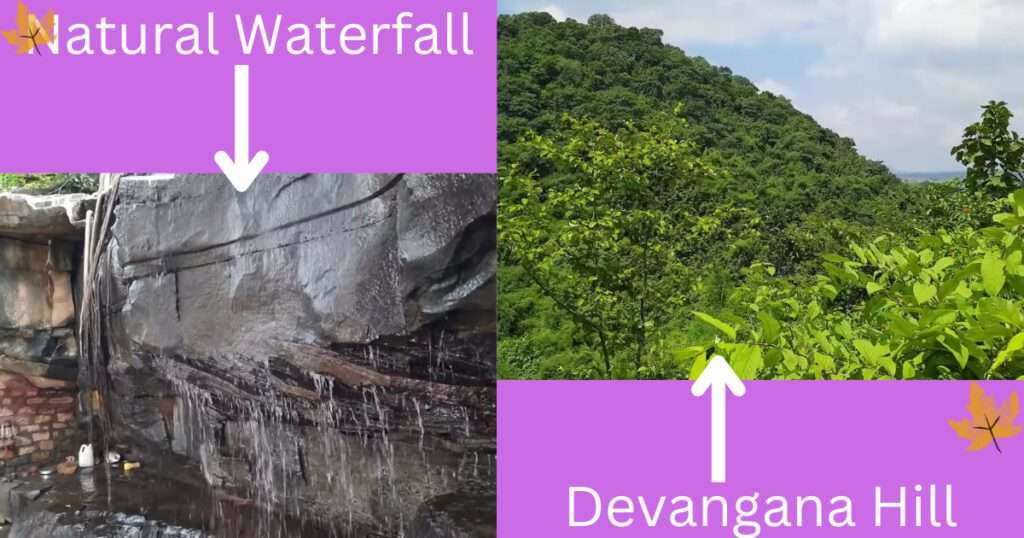
Other places to visit
- Yagya Vedi
- Sutikshna Ashram
- Sarbhang Ashram
- Mandavya Rishi Ashram
- Birthplace of Tulsidas – Rajapur
- Maharishi Valmiki Ashram
- Naandi Hanuman Ji
- Suryakund
- Ramshaiyya
- Laina Baba Sarkar
- Dharkundi Ashram
How to Reach?
-
Road
- National Highway 35, and National Highway 731A.
- NH35 gives connectivity to Varanasi and Jhansi.
- NH731A gives connectivity to Kaushambi, Pratapgarah, and Raibareli.
-
Expressway
- Chitrakoot is connected by Bundelkhand Expressway. It starts from Chitrakoot.
- It is a 296 km long expressway that connects Agra Lucknow Expressway and gives easy connectivity to Delhi.
-
Railways
- The nearest railway station is Chitrakoot Dham Karwi on the Manikpur – Jhansi/Kanpur main line. It is 10 kilometres away.
- The other two railway stations are –
- Maghjawan Railway station at a distance of 34 km which can be reached by bus.
- Satna Railway station – Satna is the main railway station from which Chitrakoot is 78 kilometres away. It can be reached by bus and personal taxi easily.
-
Airport
- The nearest functional airport is Khajuraho Airport about 175 km away.
- Chitrakoot Airport is the nearest airport. (Proposed)
-
By bus
- You can get a bus from Lucknow, Allahabad, Kanpur, Jhansi, Jabalpur, Satna and Varanasi.
- Regular bus services also connect Chitrakoot with Jhansi, Mahoba, Chitrakoot Dham, Harpalpur, Satna and Chhatarpur.
- Tuktuks and jeeps take pilgrims from one site to another. The prices are generally fixed but beware of the “official guides” and drivers who loiter in or around hotels.
Frequently Asked Questions
What is Chitrakoot famous for?
It is famous for Kamadgiri, Kamta Nath, Janki Kund, Hanuman Dhara, Gupt Godavari, Ramayan Circuit, Bharat Milap, and Sati Anasuya.
How long did Lord Rama stay in Chitrakoot?
He stayed for 11 or 11.5 years before going to Panchvati in Nasik.
Where is Chitrakoot UP or MP?
It is partially in UP and some in MP.
Which season is best to visit Chitrakoot?
Which river is in Chitrakoot?
Mandakini River, also known as Payasini river flows through Chitrakoot Dham.
How do I get from Chitrakoot to Prayagraj?
Difference between Chitrakoot and Chitrakoot Dham?
Chitrakoot is the main Kamad Giri Hill while Chitrakoot Dham is the whole city. Practically both are the same.
Editor’s Thought
While you visit this mythological city, do make sure to explore the hills of Maihar. Also do not miss the chance to meet the White Tiger at Mukundpur and explore the wildlife of Panna National Park.
Do not miss this holy city immersed in the name of Ram-Siya-Ram. Please do not fall for the tricks of the pandits for money.
Please share your experience if you visit the site.
Have a Safe Yatra…